|
more 1920s topics Nostalgia Cafe main page Nostalgia Cafe site map | 1920s Technology | ||
Records
| farewell to cylinders In the 1880s, the first phonographs were made available to the general public. Some models played cylinders, while others played flat disc records. For the first 20 years, both formats enjoyed equal popularity, but by the 1910s it was obvious that disc records were the superior format. Cylinders were phased out in the 1920s, and any consumer who wished to buy cylinder records had to order them directly from the factory. Wax cylinders were still used by offices in their dictating machines. acoustic 78 RPM records Before 1925, all recording was done acoustically: the artist performed into a recording horn, and the sound waves imbedded a groove in the wax master disc. 78 RPM was the standard recording speed....more or less. Some companies recorded at 76, 80 or even 82 RPM. Most phonographs had adjustable speed controls, so matching the playback speed to the recording speed wasn't a problem. The average record was 10 or 12 inches wide and made of shellac. electrical records Electronic recording was introduced in 1925. Now, instead of screaming into a recording horn, the artist performed into a microphone, and the recording was created by electrical wiring and amplifiers. This made an exact speed of 78 RPM an absolute necessity. The new technology gave us better sound quality, greater amplification, and made it possible to record large groups, such as full orchestras and choirs. Victor's electrical records were known as Victor Orthophonic Recordings, and could be identified by the "VE" on the label. | ----- | 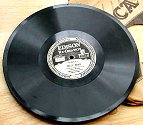 Edison Diamond Discs Edison discs were manufactured between 1912 and 1929. They were made of condensite plastic, contained five minutes of music per side, and were 1/4 inch thick. They could only be played on Edison Diamond Disc Phonographs. 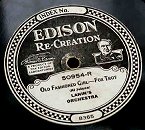 Edison claimed that the sound quality of his Diamond Discs was so good, they were not merely recordings, but re-creations. | ||
===========================================================================
===========================================================================
===========================================================================
===========================================================================
Phonographs
 Look under the lid! Be sure it IS a Victrola! --1920 music at home Floor model, tabletop and portable suitcase phonographs were popular in the 1920s. Floor model phonographs featured wooden cabinets and enclosed horns. Although the Victor Victrola came in both floor model and tabletop styles, the terms victrola and vic generally referred to any floor model phonograph with an enclosed horn, whether it was made by Victor or not. Tabletop phonographs were known as talking machines and music machines. By the 1920s, most tabletop models had internal horns, but a few still had external horns....they were usually called gramophones. At this point, some phonographs had electric motors, but most were powered by wind-up spring motors. They used steel and bamboo needles, which were replaced frequently. Except for Edison Diamond Discs and Pathe discs, all records were compatible with all models. The grooves on Edison and Pathe discs were shaped differently and required a diamond or sapphire stylus. This feature was available only on Edison and Pathe phonographs. After electronic recording was developed in 1925, new phonographs with electronic components were introduced. The Victor Orthophonic Victrola and Victor Electrola came out in 1926 and were designed especially for the new orthophonic electrical records. The 1927 Automatic Orthophonic Victrola had the first record changer. 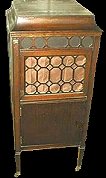 Edison Diamond Disc Phonograph music for millions In 1920, there were seven million phonographs in the United States. | ----- |
popular phonograph models Victor Victrola Victor Gramophone Columbia Disc Graphophone Edison Diamond Disc Phonograph Columbia Grafonola Victor Orthophonic Victrola Victor Electrola Brunswick Panatrope Victor Automatic Orthophonic Victrola Pathephone 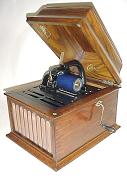 Customers who wanted to listen to their old cylinders could purchase an Edison Amberola, which was sold until 1929.  1923 Victor Victrola, with space in the cabinet for storing records 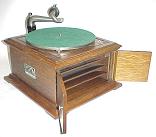 1920 Victor Victrola VI. The horn was enclosed in the base, and the volume was controlled by opening and closing the doors Edison leaves the industry In 1927, the Edison Company stopped making phonographs, and in 1929 they stopped producing cylinder and disc records. They had a massive clearance sale of all their remaining phonographs, which normally sold for $150 but could now be had for only $75. | ||
===========================================================================
===========================================================================
===========================================================================
===========================================================================
Radio
|
commercial broadcasting begins The first human voice was transmitted by radio waves in 1900. During the 1900s and 1910s, experimental radio stations were built and radio buffs listened on homemade crystal sets. Radio broadcasting became a business in 1920 when the first commercial station, KDKA in Pittsburgh, went on the air.  crystal sets crystal setsFor the first few years, pre-assembled radios were not available. Listeners purchased "do-it-yourself" kits and built their own crystal sets. Many popular science magazines also published instructions for building a radio. These sets used a wire wrapped around a Quaker Oats box, and were tuned by touching a cat's whisker to a mineral crystal. Headphones were used for listening. 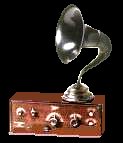 assembled & ready to go In 1922, Westinghouse put the first pre-assembled radios on the market. They were quite impressive, with polished wooden cabinets, fancy bakelite dials and vacuum tubes. Atwater-Kent, RCA Radiola, Crosley and Philco models came out in the mid and late 1920s. The first radios were powered by large rechargable batteries. Models of the late 1920s plugged into the wall. They came with an outdoor aerial that was hung from whatever high point was available....trees, gables, clotheslines and windmills. For the time being, headphones were still used for listening. superheterodyne The first radio receivers were difficult to tune, and lacked the sensitivity needed to eliminate noise and pick up distant stations. In the mid 1920s, the new superheterodyne receivers employed "frequency mixing" to solve the problem. Customers who purchased superhet radios may not have known what the word meant, but they knew they had a state-of-the-art machine. The radio revolution had begun. | ----- |  headphones vs. speakers At first, the only way to listen to the radio was with headphones. Sometimes people put the headphones in soup kettles and pitchers to amplify the sound so more people could hear it. In the mid 1920s, built-in speakers were introduced, and older models were fitted with round and tulip-horn external loudspeakers. 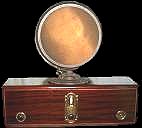 reception During the day, reception was not very good. But on below-zero clear winter nights, it was amazing how far a station could reach!  "Daddy, let's get Los Angeles!" Listeners enjoyed logging stations....using a logbook to keep track of the distant stations they found. It was fun to seek out the most distant stations possible. It also became popular to collect verified reception cards. If you heard a far-off station, you could write to them or send a pre-printed card containing the details of the program you heard. If it matched their records, they stamped the card with their call-letters and sent it back. connected to the world From the very beginning, many radios were purchased by farmers. Owning a radio ended the intense isolation of farm life, and allowed rural families to feel like they were a part of the outside world. | ||
===========================================================================
===========================================================================
===========================================================================
===========================================================================
At Work
still to come! | ----- | |||
return to
Products, Fads & Fun
other pages in this section:
Activities & Trends
return to the 1920s main page